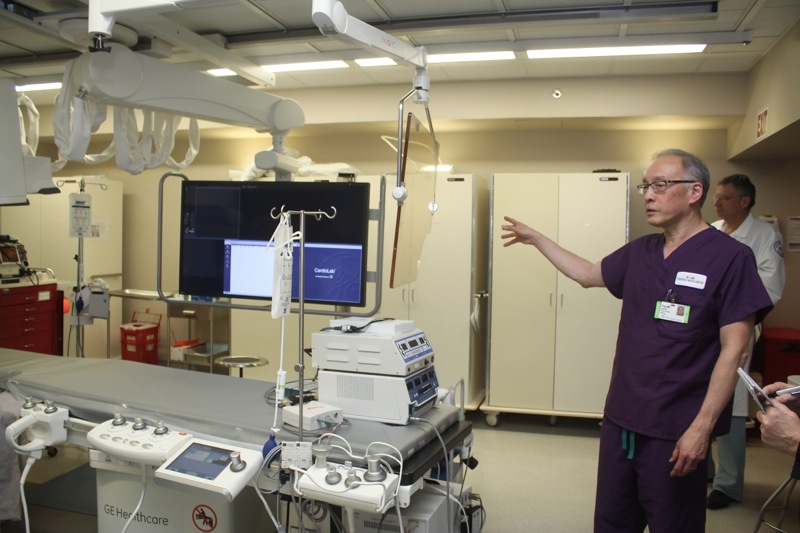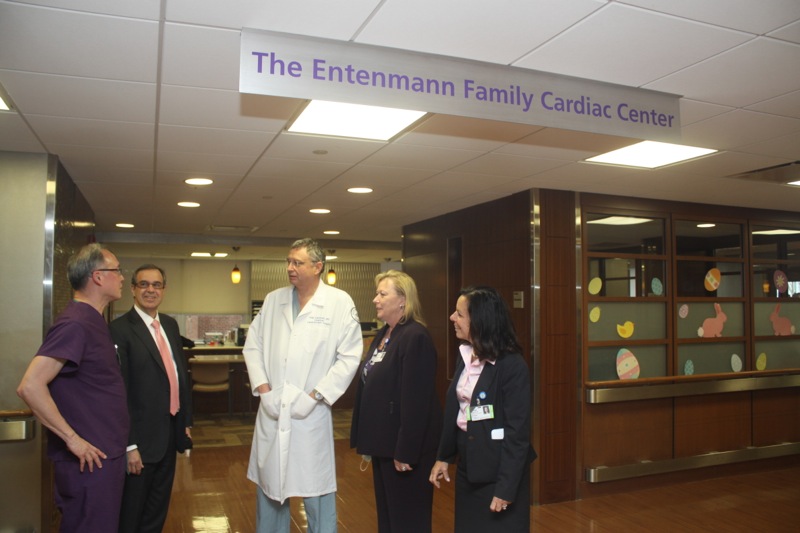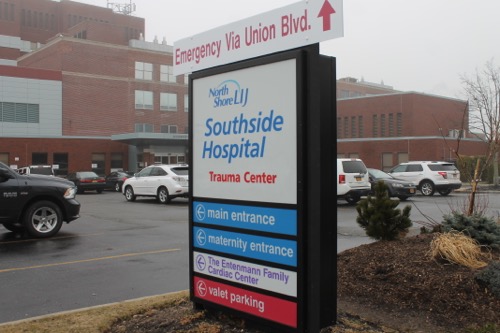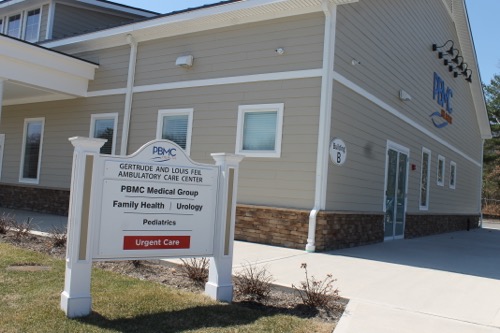Opening a cardiac catheterization lab at Peconic Bay Medical Center will be the top priority for North Shore-LIJ when it takes over operation of the 64-year-old Riverhead hospital.
“We have every intent of opening a cardiac cath lab at Peconic Bay as soon as we can,” North Shore-LIJ executive vice president and chief operating officer Mark Solazzo told RiverheadLOCAL.
In fact, “cardiac cath” services are so urgently needed on the East End, North Shore-LIJ will look to get started on the regulatory approvals even before Peconic Bay’s current contract with Stony Brook University Hospital expires in June 2016, Solazzo said.
“We’d like to enter into a discussion [with Stony Brook] to see if they would be willing to allow us to shorten that contract so we can start working with our new partner,” Solazzo said.
Peconic Bay and North Shore-LIJ announced March 27 that PBMC would become part of the 19-hospital health system, breaking ranks with Stony Brook University Hospital, with which it has a contractual relationship for emergency and radiology services.
“If we can get through the state approvals quickly and if they’d allow us, we’d start working on this immediately,” Solazzo said.
North Shore’s commitment to provide cardiac catheterization services at Peconic Bay was a key factor in PBMC’s decision to merge with the massive health system — the 14th largest in the United States — PBMC officials told RiverheadLOCAL during a March 30 meeting. Its other potential partner, Stony Brook University Hospital, with which PBMC had been discussing a potential merger for some time, would not commit to putting a cardiac cath lab in Riverhead, according to PBMC board officers.
It’s key because having a cardiac cath lab, where cardiologists can perform angioplasty or percutaneous coronary intervention — PCI for short — saves lives.
PCI should be done within 120 minutes of a patient’s first contact with EMS, according to cardiologists, who repeat the mantra: “Time is muscle. Time is life.”
The nearest PCI-capable hospitals in Suffolk are Brookhaven Memorial in East Patchogue and Stony Brook University in Stony Brook. (The state health department gave contingent approval last August for the construction of a PCI-capable cardiac cath lab by Stony Brook at John T. Mather Memorial Hospital in Port Jefferson.) They are at such a distance from the residents of the East End that providing treatment within the 120-minute window of time is difficult at best; more frequently, it’s impossible.
The need on the East End, which has a higher proportion of 55-and-over residents than both Suffolk as a whole, Nassau and the U.S. overall, is great, PBMC president and CEO Andrew Mitchell said. East End patients required 592 emergency or urgent coronary angioplasty procedures in 2013, according to statistics provided by PBMC. Cardiac mortality rates are higher on the East End than in western Suffolk, according to Suffolk Regional Emergency Medical Services Council data.
“Life-saving — the minutes that count — that’s the cardiac cath lab,” Dr. Alan Hartman, North Shore-LIJ chairman of cardiovascular and thoracic surgery, said in an interview this month at Southside Hospital in Bay Shore, where North Shore not only established three cardiac cath labs but also, in 2011, a surgical cardiology unit where Hartman and his colleagues perform open heart surgery every day.
North Shore-LIJ has no immediate plans to build an open heart surgery program at Peconic, Solazzo said.
“I would never say never, but that’s a whole other level of development in care,” he said.
Even with on-site surgery capability, the procedure is the same, Hartman said.
“When you come off the street having a heart attack, what you need is to get to a cath lab as quickly as possible,” Hartman said. “If you have a blocked vessel, you don’t go right to the OR, you go to cardiac cath lab and get that vessel open. That’s what we’re talking about setting up at Peconic.” If the cardiologists determine that surgery — such as a bypass or valve replacement — is needed, the patient would be transported to Southside. North Shore has more than 100 ambulances and its own helicopter.
Cardiologists at Southside annually perform about 700 cardiac catheterizations, including stents — which keep vessels open, said Dr. Larry Ong, North Shore-LIJ’s head of cardiac catheterization. Cardiac catheterization has reduced the mortality rate for acute heart attacks to 2 percent, Ong said.
“I’m sorry. I can see no reason why that institution [PBMC] should not have a cardiac cath lab,” Solazzo said.
PBMC should also at least be a level-one trauma center, he said.
‘Part of the family’
All services at all hospitals operated by North Shore-LIJ share the same leadership. All hospitals are held to the same standards, Solazzo said.
“Once you’re part of our system you’re part of the family,” Solazzo said. “We have one bottom line for the whole system. It was an easy decision to move North Shore’s cardiac open heart program to Southside,” he said. “It made sense to bring it to the community as long as Alan said ‘I can safely do it.’ If we can bring something safely to a community that’s where we should do it.”
Solazzo emphasized that North Shore’s philosophy of care is “diametrically opposed” to the “hub and spoke” model, where one medical facility is at the center of a system, as a hub, where services are concentrated, with other facilities — the spokes — feeding that hub.
State Senator Ken LaValle, who was critical of Peconic Bay’s decision to merge with North Shore, told RiverheadLOCAL on March 27 he has always envisioned a health care system on the East End with Stony Brook at its hub and the three East End hospitals as the spokes.
“I’m not willing to sit by and watch health care on the East End be ceded to a Nassau County facility,” LaValle said.
Those words make North Shore-LIJ officials bristle. Both Solazzo and Hartman live in Suffolk County, as do some 19,000 other North Shore-LIJ employees. (The health system’s total employee roster exceeds 54,000, a number that will reach near 60,000 by the end of this year, Solazzo said. It is the largest private sector employer in the state.) Solazzo points out that North Shore already operates four other hospitals in Suffolk and many ambulatory care facilities and physician practices in Suffolk. The health system has more than 400 ambulatory care facilities and employs more than 2,800 physicians full-time.
“Health care is local,” Solazzo said. “You’ve got to take care of the community and where you can do it safely is where you should do it.”

North Shore took over operation of Southside Hospital in 2005. The community hospital had already been part of the North Shore system but was operated independently. In 2005, Solazzo said, Southside got into financial difficulty and asked for help.
North Shore’s initial investment in Southside topped $160 million, Solazzo said. Some of that investment was staffing, some was equipment and supplies, and some was “bricks and mortar.” Since 2005, the health system has put about $300 million into Southside, transforming it into a tertiary care hospital — the only one in Suffolk besides Stony Brook. It will invest another $300 million into Southside over the next several years, Solazzo said. It’s building a cancer care center, tripling the size of the hospital’s emergency department, building a women’s radiology center and planning for the construction of a new ICU, among other things.
“In this day and age you want to have choices,” Hartman said. “In Suffolk, the choices were slim, especially for tertiary care,” he said. “It’s a personal thing. We live here. We need to make sure you have what you need. When emergencies happen, they happen and you want appropriate care close to home. Here [at Southside] we achieved something where we feel we can bring our own family for care.”
Solazzo said standalone institutions can’t survive and thrive any more.
“You need a strong partner to make the investments in the facility you want to make and grow the program. Margins in health care are so slim you can’t throw off the extra cash you need that allows you to invest back into the community,” Solazzo said. “You don’t want to stay at status quo — that just allows you to get by. It’s not good for the community you serve.”
Peconic Bay is a good fit with North Shore, the hospital executive said. “With any partnership, you look at three things.
“Do they share a common culture? Can we work with them? Do they understand our commitment to patients, our commitment to quality and our belief that education and research is important to our mission?
“Do they share the same vision? We believe in pushing care out having as many access points for the consumer as they want. However the public wants to interact with us, we want to be available for them,” he said.
“Finally, we do an assessment, a deep dive into the institution. We do our due diligence. Can we add value? Can we improve the situation? If not, then we don’t do it,” Solazzo said.

“Peconic obviously met all three hurdles,” he said. “We’ve had a relationship with them for a long time, as affiliates before the Stony Brook adventure. We’re excited because we know what kind of value we can bring.”
Solazzo said PBMC has “a nice strong board” and a good relationship with its community. Both are vital components for North Shore, he said.
“We’re starting from a very different place there than in many other hospitals we’ve taken over. It’s a position of strength. It’s awfully nice.”
Correction: A previously published version of this story stated that a cardiac cath lab exists at John T. Mather Memorial Hospital in Port Jefferson. The state health department last year gave its contingent approval for the facility, which is not yet completed.
The survival of local journalism depends on your support.
We are a small family-owned operation. You rely on us to stay informed, and we depend on you to make our work possible. Just a few dollars can help us continue to bring this important service to our community.
Support RiverheadLOCAL today.
































